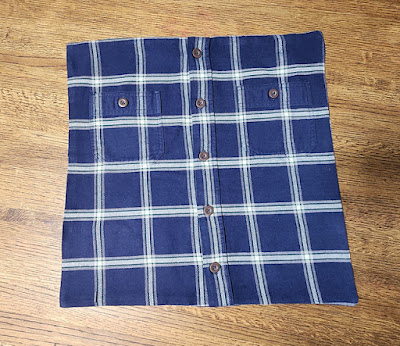When my father-in-law died in 2019, one of his daughters, my sister-in-law Linda, saved one of his heavy plaid flannel Wrangler shirts with the idea of making it into a memory pillow, and I was honored when Linda asked me if I would be willing to make the pillow for her.
With a quick Google search for "memory pillow" or "how to make memory pillow," you will easily find many examples and tutorials for how to make one like this.
I was fairly sure how to go about it, but I watched this video tutorial by Lesley Chandler on YouTube to have the steps clear in my mind before starting.
To make one of these, you need to know the basic skills for working with a sewing machine. You're basically cutting two squares out of the shirt and then sewing them together to make a cover that will fit a square pillow form. If you're using a button-front shirt like I did, you don't even need to leave a gap in the sewing for turning the pieces right-side out, because the shirt's button front can serve that purpose. And, in the future, you can also open the buttons to remove the pillow form any time you want to launder the pillow cover, so it's a win-win.
Begin by laying the shirt out flat, with all the buttons buttoned, on a large tabletop. Iron the shirt to help the fabric lie evenly if it has any wrinkles. I measured the distance across the front between the sleeve seams to get an idea of what the largest size pillow cover that the shirt would make. It was about 18 inches between the sleeve seams across the front.
I had an extra 18-inch square Ikea feather pillow form on hand that I wanted to use for this project. Knowing that the finished pillow cover will be less than the full dimensions of the cut fabric (because of the amount taken up by the seam allowances), I figured that my finished pillow cover would juuuust barely be large enough to work with that pillow form. But square pillow forms come in different sizes, so you should be able to find one that will fit your particular pillow cover.
You can make the cutting easier by first cutting a piece of newspaper into the shape/dimensions to act as the pattern. Since the distance between the sleeve seams was 18 inches, I decided to cut an 18-inch square to be my pattern.
I laid the shirt out flat on a cutting mat on my work table and positioned the pattern on top. I adjusted the position of the pattern until I had it where I wanted it, using the placement of the shirt pockets as a guide to where the pattern should be placed. When I was happy with the placement, I pinned the pattern in place and used my fabric scissors to carefully cut around the pattern. You could use a rotary cutter and ruler if you're comfortable with those. I have those tools but didn't want to risk making a bad cut on this precious shirt.
After the pieces are cut, set aside the pattern and excess fabric. Turn the pillow cover squares so the right sides are facing each other and pin them together. Then sew them together using an appropriate seam allowance, carefully easing the machine through the bulkier areas across the button placket. I used about a 1/4-inch seam allowance for this.
After sewing all the way around, trim the excess fabric at the corners. Then unbutton the shirt's buttons and turn the pillow cover right-side out, using a blunt tool to help poke out the corners. Rebutton the buttons and press the sewn pillow cover again to smooth the seams.
The final step is to open the buttons again and place the pillow form inside. Button the buttons, and you now have a wonderful memory pillow of your loved one's shirt that you can hug whenever you want to.
In her video tutorial, Lesley Chandler shared that there are sellers on Etsy who make custom iron-on patches with a lovely little verse that can be added to a memory pillow project. She suggested this one and placed it on a bottom-front corner of her pillow. I think the patch would also work on a bottom corner of the back side of the pillow.
I wasn't sure if Linda would want a patch like that on her pillow, however, so I sent her a link to it so she could see what it was and read about it, and then decide if she wanted it. She could always opt to add a patch to her pillow cover later, because the only equipment needed to add it is an iron.
After completing the memory pillow, I looked at the fabric scraps left over and decided there was plenty of fabric left to make a small memento for each of my father-in-law's four children, including Linda, my husband, and their other two sisters. I figured a keychain wristlet would be lovely and useful, and I already had the clasp hardware on hand.
I like this tutorial by Devi Therkildsen on YouTube for making "seamless" fabric wristlets that work with the type of clasp hardware I have on hand. Each wristlet requires a piece of fabric that's 12 inches long by 4 inches wide, and also a piece of lightweight interfacing of the same size if your fabric is lightweight. (I didn't use interfacing on these flannel wristlets because the fabric itself was already heavy enough to be durable.) You can see the four finished wristlets next to the finished memory pillow in the lead photo of this post.













